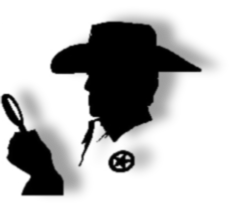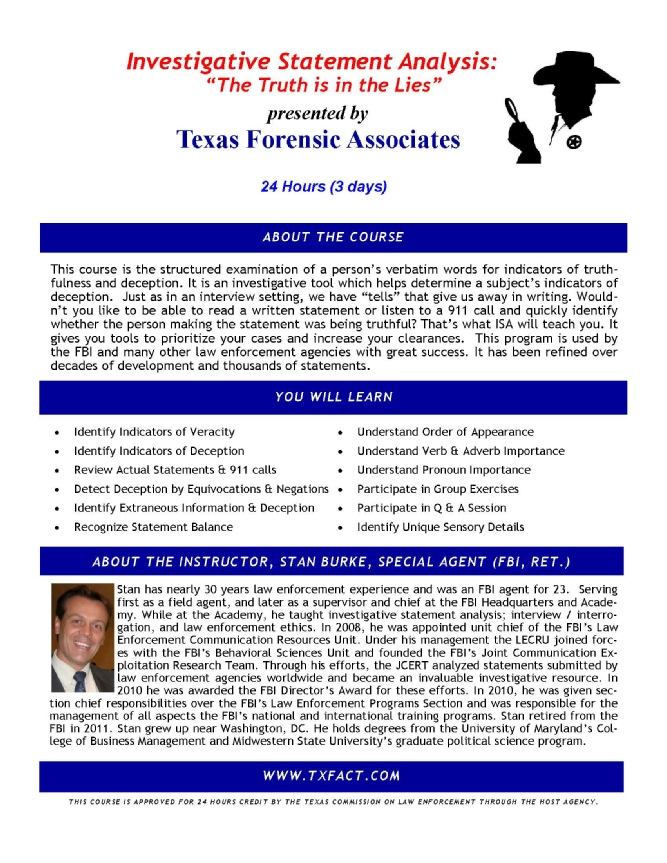
TxFACT LLC -




A professional consortium comprised of subject matter experts in a wide range of scientific and investigative disciplines providing forensic education, training and consultation.
VERITAS ABS INDICO
“Truth Through Evidence”

Shooting Reconstruction, shooting reconstruction expert, bloodstain, bloodstain pattern analysis, bloodstain pattern analysis expert, crime scene investigation, crime scene reconstruction, forensic investigation, forensic training, bloodstain pattern analysis training, bloodstain training, shooting reconstruction training, crime scene training, police training, cop training, best crime scene training, interview training, interview, interrogation, interrogation training, statement analysis, statement, statement training, 911 analysis training, lie detector, lie training, catch crooks, find the truth, detect lies, stanley burke, brian harris, stan burke, rudy flores, nick webb, blood , bullets, fingerprints, walter henson, fingerprint training


The program is taught from a hands-
BLOOD, BULLETS AND MORE 24 HRS

TxFACT Training
Our training classes are hosted by colleges, law enforcement agencies and training academies across Texas and in surrounding states. Visit our home page for a class near you.
At TxFACT, we focus on developing skills the attendee can use.
“Forensics Without Fluff”
***For information about how your agency can host a class, contact us!***
Training


This is a hands-
***Required Equipment***
A digital SLR camera, tripod, shutter release cable, external flash with sync cord and flashlight are required for the practical exercises. Students should also have the camera user manual. (Point and Shoot Cameras are not acceptable.)
DIGITAL POLICE PHOTOGRAPHY 24 HRS


This is a 40-
*Note: Attendance in this course will not qualify you as an expert in Bloodstain Pattern Analysis. Only a court or certifying entity can designate an expert.
YOU WILL LEARN:
To recognize and identify bloodstain pattern evidence at the scene.
To properly document and preserve bloodstain evidence.
To identify the various bloodstain patterns constituting evidence at the crime scene.
To properly collect and preserve suspected blood samples to be submitted to a qualified crime laboratory for confirmatory testing.
The proper evaluation of the bloodstain evidence and patterns.
To document their observations in written reports.
To properly identify mechanisms by which specific stains may have been created.
Equipment selection and use for investigating crimes scenes with bloodstain evidence.
Investigative protocols for violent crime scenes.
Recognize biohazards and personnel safety procedures.
BLOODSTAIN PATTERN ANALYSIS 40 HRS


This is a hands-
YOU WILL LEARN:
Firearm safety and nomenclature
Impact angle calculation using elementary geometry and basic physics
Bullet pathway identification using lasers, trajectory rods and string
Interpretation of bullet impacts on different objects such as a vehicle and walls
Photographic documentation for shooting scenes
Bloodstain patterns at shooting incident scenes
Collection of shooting incident scene evidence
Fundamentals of interior, exterior, and terminal ballistics
Examination of bullet holes and measurement of impact angles
Shot sequencing in certain substrates
Determine likely locations of victim(s) and suspect(s) based on evidence
Measuring methods and devices
*Note: Attendance in this course will not qualify you as an expert in Shooting Reconstruction. Only a court or certifying entity can designate an expert.
INVESTIGATION AND RECONSTRUCTION OF SHOOTING INCIDENTS
40 HRS


This course is for criminal justice personnel, officers and laboratory technicians who work with fingerprints and is designed for beginners. No experience is necessary. The objective is to train the student in fingerprint pattern recognition and to compare and identify fingerprints. Instruction on the history of fingerprints, basic physiology of friction ridge formation, the taking of inked fingerprints, basic tools/ methodology used in fingerprint comparison and basic courtroom testimony dealing with enhanced punishment (pen packet testimony) is included. Note: This course does not include work with latent prints.
YOU WILL LEARN:
Introduction to Fingerprints
Fingerprint History
Fingerprint Physiology
Fingerprint Definitions
Fingerprint Pattern Identification
Fingerprint Pattern Interpretation
Fingerprint Pattern Comparison
Recording Inked Fingerprint Impressions
Courtroom Testimony and Demeanor for Fingerprint Evidence
Introduction to AFIS
BASIC FINGERPRINT IDENTIFICATION 40 HRS


This course provides an extensive practical application of Friction Ridge Comparisons using both fingerprints and palm prints. Instruction also encompasses the scientific methodologies of examinations on friction ridge impressions as well as the scientific basis for friction ridge identification (individualization). Students will be trained in the presentation of expert testimony as well as courtroom demeanor. The class will then participate in an introduction to moot court presentations.
YOU WILL LEARN:
Fingerprint Identification
Palmprint Identification
ACE-
Friction Ridge Comparisons
Fingerprint Individualization
Fingerprint Pattern Interpretation
Fingerprint Pattern Comparison
Comparison of Latent Fingerprint Impressions
Courtroom Testimony and Demeanor for Fingerprint Evidence
LATENT FINGERPRINT COMPARISON - INTERMEDIATE 40 HRS


This course provides an extensive practical application of Friction Ridge Comparisons using both fingerprints and palm prints. Instruction also encompasses the scientific methodologies of examinations on friction ridge impressions as well as the scientific basis for friction ridge identification (individualization). Students will be trained in the presentation of expert testimony as well as courtroom demeanor. The class will then participate in an introduction to moot court presentations.
YOU WILL LEARN:
ACE-
Palmprint Identification
Level 1, level 2 and level 3 detail in latent print comparisons
Palm print orientation and palm print search clues in latent print comparisons
Fingerprint Individualization and Comparison
Analysis of distorted and complex latent prints
Comparison of Latent Fingerprint Impressions
Courtroom Testimony and Demeanor for Fingerprint Evidence
Daubert and post-
LATENT FINGERPRINT COMPARISON - ADVANCED 40 HRS


The “Basic Criminal Investigation: Crime Scene to Courtroom” program
prepares the attendee for the transition from their current position to an
investigative assignment such as Detective or Criminal Investigator.
The BCI course prepares officers to manage a wide variety of common
criminal investigations from the initial scene response to case preparation
and presentation for prosecution. An emphasis is placed on the preparation
of affidavits, preparation and execution of search and arrest warrants,
interview and interrogation procedures, and the identification,
collection and preservation of physical evidence.
YOU WILL LEARN:
- •The Crime Scene
- •Injury & Death Investigations
- •Sex Crimes
- •Robbery Investigations
- •Property Crime Investigations
- •Crimes Involving Computers
- •Case Management
- •Interviews & Interrogations
- •Subpoenas, affidavits and search warrants
- •Crime scene search & protection
- •Crimes against persons
- •Utilizing informants
BASIC CRIMINAL INVESTIGATIONS -

INVESTIGATIVE STATEMENT ANALYSIS 24 -







